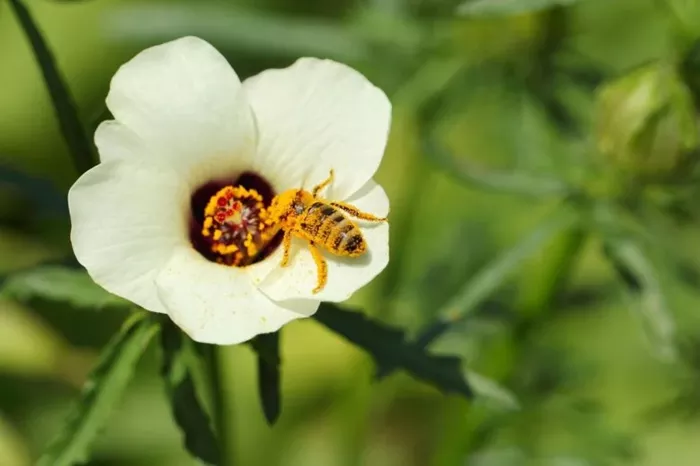Hibiscus flowers utilize specific petal patterns, determined early in their development, to attract bees. The patterns, particularly the size of the bullseye on the petals, significantly impact pollination efficiency and plant evolution, according to a study from the University of Cambridge’s Sainsbury Laboratory.
Pre-Patterned Petals Key to Pollination
The research, published in Science Advances, reveals that hibiscus flowers have an invisible pre-pattern established early in petal formation. This pre-pattern dictates the size and shape of the bullseye, a petal pattern that is crucial for attracting bees. The larger the bullseye, the more bees are drawn to the flower, increasing the likelihood of successful pollination.
The study also showed that bees prefer larger bullseyes, flying 25% faster between artificial flower discs with larger patterns. This increased speed could enhance both the bees’ foraging efficiency and the plant’s reproductive success.
Early Petal Development Determines Bullseye Size
Using two species of hibiscus, Hibiscus trionum and Hibiscus richardsonii, along with a genetically modified line of H. trionum, researchers examined how bullseyes form. They found that petal patterns emerge long before visible color appears. This pre-pattern acts as a “paint-by-numbers” system, where specific regions are pre-determined to develop certain colors and textures.
The team discovered that the petal surface begins forming a pre-pattern early in development, dictating future bullseye dimensions. The study indicates that plants have multiple ways of controlling and adjusting the size of these patterns, suggesting possible implications for plant evolution. By fine-tuning bullseye patterns, plants may increase their chances of attracting pollinators and even target different insect species.
The Crescent-Shaped Pre-Pattern
The researchers observed a crescent-shaped pre-pattern on the petal surface before any visible pigment appeared. As the petal develops, this pre-pattern dictates where the bullseye will form.
Dr. Lucie Riglet, the lead author, noted that when the petals are still greenish and tiny, with only about 700 cells, there is no visible pigment or difference in cell size. However, as the petal expands to around 4,000 cells, a distinct region begins to form where the cells are larger, indicating the pre-pattern. These larger cells mark the boundary between the purple and white areas of the petal, essential for the bullseye’s formation.
Modeling Petal Growth and Pollinator Attraction
A computational model developed by Dr. Argyris Zardilis provided additional insight into how these patterns form and vary in size. The combination of this model and experimental results showed that hibiscus flowers can alter bullseye size early in development by adjusting cell expansion and division. This gives the plants flexibility in modifying their patterns as they grow.
To test the effectiveness of different bullseye sizes in attracting pollinators, the researchers used artificial flower discs mimicking three different bullseye sizes. The bees overwhelmingly preferred the larger and medium-sized bullseyes and moved between these flowers 25% faster than they did with smaller bullseyes.
Dr. Riglet explained the significance of this: “Bees need to conserve energy while foraging. If a bee can visit more flowers in the same time frame, it’s advantageous for both the bee and the plant.”
Evolutionary Implications of Pre-Patterning
The research suggests that the ability to establish a pre-pattern early in development might have deep evolutionary roots. This mechanism could help explain the wide variety of flower patterns seen across different species. The team plans to investigate whether similar pre-patterning processes occur in other plant structures, such as leaves.
This study not only deepens our understanding of how flowers attract pollinators but also sheds light on the role these pre-set designs play in plant survival and evolution.
Bumblebee Preference for Larger Bullseyes
The study found that bumblebees can distinguish between bullseye sizes on artificial flower discs. The bees consistently preferred the larger bullseye of Hibiscus trionum over the smaller pattern of Hibiscus richardsonii, flying faster between flowers with bigger bullseyes.
H. richardsonii is a critically endangered species native to New Zealand, while H. trionum is widespread across Australia, Europe, and North America. The larger bullseye of H. trionum may contribute to its reproductive success, suggesting that bullseye size plays a key role in the survival of these plants. Further research is needed to determine whether this feature helps H. trionum thrive in a wider range of environments.
This study illustrates the intricate relationship between flower design, pollinator behavior, and evolutionary success. The findings could help researchers understand how biodiversity is generated and maintained in nature.
Related topics:
- Dahlias Shine Bright as Gardens Fade
- Sedum: This Easy-to-Grow Purple and Pink Plant Attracts Pollinators
- Boosting Soil Health Enhances Sweet Pepper Plant Resilience


